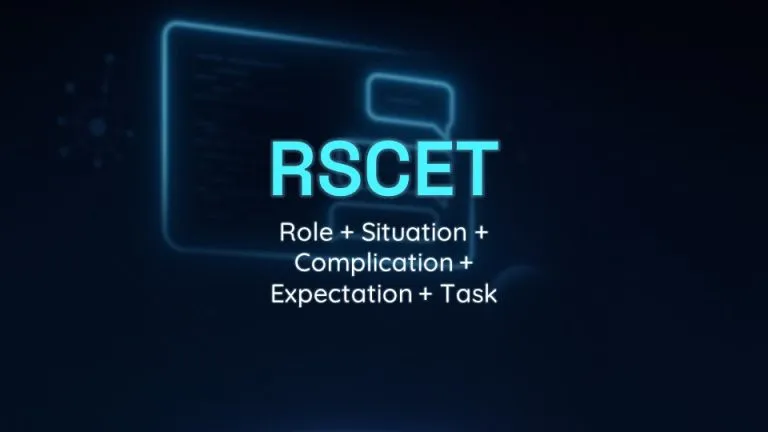RSCET Framework: Role, Situation, Complication, Expectation, Task

The problem isn’t always simple — and neither should the AI’s response be. The RSCET framework was designed to structure prompts in complex scenarios where there are obstacles, specific objectives, and a need for a clear, strategic, and contextualized response.
By using this structure, you help the AI understand not just what needs to be done, but also why and in what context. It’s ideal for situations involving real-world challenges, multiple variables, and critical decisions.
What Is the RSCET Framework?
The RSCET framework is designed to address challenging scenarios, offering a clear path for the AI to understand and resolve your request. With five well-defined components, it ensures that each aspect of the problem is addressed with precision. Let’s go over each of them and see when this framework is the best choice.
Framework Components
- Role: Defines who the AI should be, like “business strategist” or “IT consultant”. This shapes the perspective of the response.
- Situation: Describes the current context, providing the necessary background for the AI to understand the scenario.
- Complication: Points out the main problem or obstacle, highlighting what needs to be overcome.
- Expectation: Sets the desired outcome, such as “a viable plan” or “practical suggestions”.
- Task: Specifies what the AI should do, such as “create a strategy” or “list solutions”.
Together, these elements form a prompt that clearly guides the AI, turning complex situations into useful responses.
When to Use It?
RSCET is ideal when you’re facing a challenge that requires analysis and structured action. Use it if:
- You need to solve a problem with multiple layers or variables.
- You want a strategy that takes specific obstacles into account.
- You’re looking for a practical plan to apply in real-world situations.
- The situation demands more context than a simple, direct request.
- You want the AI to think like a professional or specialist when facing a dilemma.
For example: “As a [Role], in [Situation], I face [Complication]. I expect [Expectation], so please [Task].”
Practical Examples of RSCET in Action
To show how RSCET works in practice, here are three examples illustrating its application in real-life scenarios. See how it organizes ideas and delivers effective solutions.
Example 1: Strategy to Increase Retention in Online Courses
Context: You manage an online course platform and want to keep students engaged.
As a digital education expert (Role), in an online course platform offering a variety of content (Situation), I face the challenge of low student retention after the first module (Complication). I expect a strategy to increase engagement throughout the course (Expectation), so create a plan with specific actions to encourage continuation (Task).Why it works: The “Role” brings expertise, the “Situation” provides context, and the “Complication” defines the problem. The “Expectation” aligns the objective, and the “Task” calls for a concrete solution, ensuring focus and applicability.
Example 2: Recovering Engagement on Social Media
Context: You’re responsible for a brand’s digital presence and performance has dropped.
As a digital marketing strategist (Role), given the drop in engagement on our brand’s social media over the past 3 months (Situation), and considering that we’ve already tested formats like reels, lives, and carousels without significant success (Complication), I expect a practical plan to regain reach and interaction with our target audience (Expectation). Please develop a strategy with at least three new actions or recommended adjustments (Task).Why it works: The prompt shows what’s been tried, the current scenario, and what’s expected from the AI, avoiding repetitive or shallow ideas.
Example 3: Product Launch Plan in a Saturated Niche
Context: A startup is launching an app in a highly competitive market.
As a digital product innovation consultant (Role), we are about to launch a personal organization app aimed at college students (Situation). The issue is that there are already many similar apps, with large players dominating the market (Complication). We expect a differentiation plan for the launch, highlighting our unique cognitive profile-based customization feature (Expectation). Create a market entry strategy that leverages this feature and includes suggestions for initial brand positioning (Task).Why it works: The structure helps the AI understand the market challenge and guides it to develop a proposal that explores the key differentiator.
Tips to Get the Most Out of RSCET
RSCET is versatile and can be fine-tuned to perfectly fit your needs. Here are some practical suggestions to make it even more effective.
Customize to Your Goal
- Role: Choose a role that matches the tone or expertise needed. “Data analyst” is technical, while “mentor” may be more accessible.
- Situation: Be specific with the context. “A physical store” is different from “a growing digital startup”.
- Complication: Detail the problem to avoid generalizations. “Lack of customers” is vague; “low site traffic” is precise.
- Expectation: Define a measurable or clear result, like “increase sales by 15%” or “improve internal communication”.
- Task: Match the action to the level of detail you want. “Give ideas” is broad; “list 3 steps” is focused.
Quick Example: “As a project manager (Role), in a remote team working across time zones (Situation), I face coordination difficulties (Complication). I expect a method to align the team (Expectation), so please create a plan with daily routines (Task).”
Start Using RSCET Today
RSCET is a powerful tool for tackling challenges with clarity and obtaining practical AI-driven solutions. It combines context, problem analysis, and targeted actions, making your interactions with LLMs more productive and aligned with your objectives. Whether for business strategies or operational issues, this structure is a shortcut to consistent results.
🎯 Quick Summary: RSCET defines who is acting (Role), the context (Situation), the obstacle (Complication), the goal (Expectation), and what to do (Task).
🔗 Want to explore more frameworks like this?
Check out the Practical Guide to Prompt Techniques, Frameworks, and Formulas for LLMs, with dozens of detailed and applicable structures for different contexts and goals, plus techniques and prompt engineering tips.
📘 Bonus tip:
Download the free eBook “Prompt Engineering Unveiled”, featuring easy explanations, practical examples, and strategies ranging from basic to advanced to master communication with AI.



